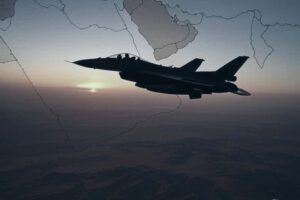
Iran’s grand strategy of forging a unified front of regional terror armies against Israel is rapidly unraveling. Tehran’s proxy doctrine lured its allies into a death trap, dragging them into disastrous conflicts detached from their core interests.
As the Gaza war escalated, Iran’s strategy set off a chain reaction that left some of its key proxies battered and vulnerable, falling like dominoes. This exposed serious cracks in Tehran’s regional ambitions.
Mideast affairs journalist Gregg Carlstrom pointed out that Iran’s concept was flawed from the start. It overlooked the limitations of relying on a patchwork of militias with different interests and limited capabilities, he wrote.
Tehran’s strategy assumed that these scattered groups – each with its own priorities – would coordinate seamlessly in a concerted effort against Israel. The theory looked good on paper, but it collapsed in practice.
Hamas attacked Israel on October 7 based on the assumption that Iran would quickly activate its regional network. Yet instead of a coordinated assault from all sides, Israel faced only isolated, low-intensity strikes. Initially, this may have seemed like a calculated move, but it increasingly backfired.
Hezbollah’s avoidable disaster
First, Israel was able to concentrate its military efforts on Hamas, devastating the Gaza terror base – an outcome the Iran failed to prevent. From there, the situation only worsened for Tehran and its allies.
Hezbollah became locked in a low-intensity conflict, enduring mounting casualties and a heavy toll on its resources. Israel ultimately unleashed overwhelming force, wiping out the organization’s leadership and destroying a significant part of its military arsenal.
For Hezbollah – mainly concerned with seizing control in Lebanon and serving as a deterrent against an Israeli strike on Iran’s nuclear sites – this was an entirely avoidable catastrophe. The forced link to Gaza, imposed by Tehran’s vision, backfired spectacularly.
A similar scenario played out on a smaller scale with the Houthis in Yemen. Following Tehran’s orders, the Houthis launched attacks on Israel, despite Yemen’s geographic distance and lack of direct interest in the conflict.
This prompted an Israeli retaliatory strike on Yemen’s Hudaydah Port, a key source of revenue for the Houthis, dealing them a severe blow. Once again, an Iranian proxy was dragged into a fight with no clear imperative, only to pay a very high price.
Iran’s plan in jeopardy
The broader consequences for Iran are dire. Tehran had invested billions in Hezbollah, providing advanced weapons and military aid, only to see much of it wiped out in a matter of weeks by Israeli firepower.
Beyond the military and financial losses, Iran’s regional reputation suffered a serious blow. The events revealed Tehran’s inability – or perhaps unwillingness – to intervene directly when its proxies are under fire.
In Lebanon, Tehran chose to remain on the sidelines at a critical juncture despite calls from its allies in Beirut for direct Iranian intervention. This left Hezbollah to absorb the full force of Israel’s assault alone.
Overall, Iran’s reliance on distant, often disconnected militias to fight its battles has boomeranged, leaving several proxies depleted and Tehran’s regional ambitions in jeopardy.
At this stage, Iran’s plan to encircle Israel with a “ring of fire” seems to be falling apart, leaving Tehran to reassess the costs and viability of its strategy.
The ripple effects of this setback could eventually alter the balance of power in the region, as Iran’s enemies – in Israel and across the Middle East – gain confidence from its strategic miscalculations. [here’s more on Hezbollah’s 3 deadly errors]


